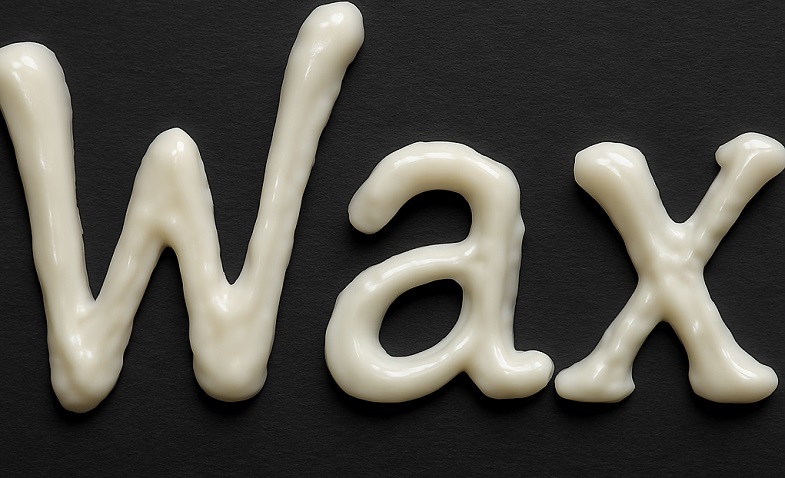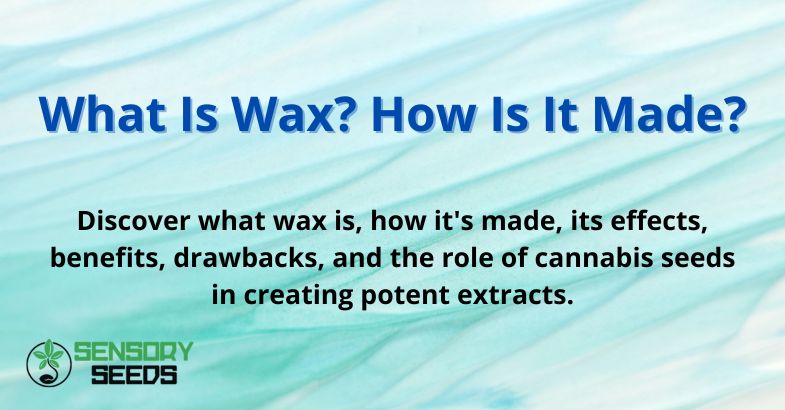Published on: 16/05/2025
Discover what wax is, how it’s made, its effects, benefits, drawbacks, and the role of cannabis seeds in creating potent extracts
Wax, one of the most appreciated and sought-after cannabis extracts, is gaining increasing popularity in the marijuana world, thanks mainly to its incredible potency and the versatility it offers. This concentrate, known for its waxy consistency and high THC concentration, has captivated consumers seeking more intense experiences than those offered by traditional cannabis consumption. With its potency, which can exceed 80% THC, it’s an ideal choice for those looking for a quick and powerful effect, as well as for those seeking a more discreet way to consume marijuana.
In this article, we will dive into the world of wax, exploring in detail what this concentrate is, how it’s produced, and the most common consumption methods. We’ll also analyze the positive effects it can have on the body and mind, as well as possible side effects, providing you with a complete and informed view of this product. Furthermore, we’ll discuss the main advantages and disadvantages of wax compared to other cannabis consumption methods, offering a balanced and practical overview for those interested in trying it.
Additionally, for a deeper understanding of this concentrate, we will examine the importance of choosing the right cannabis seeds used in the production of wax. The use of high-quality marijuana seeds, such as feminized cannabis seeds, which ensure the production of seedless flowers, or autoflowering and fast-flowering cannabis seeds, which offer rapid growth, can significantly impact the quality and potency of the final concentrate.
What Is Wax?
Wax is a cannabis concentrate that has seen a surge in popularity in recent years, thanks to its high potency and unique waxy consistency. The name “wax” comes from its texture, which can range from soft and sticky to more solid and crumbly, resembling beeswax. This concentrate is produced by extracting the psychoactive and therapeutic compounds of cannabis, such as THC (tetrahydrocannabinol) and CBD (cannabidiol), directly from cannabis flowers. The final product contains a concentration of active compounds much higher than that found in traditional cannabis flowers, making it particularly popular among those seeking more powerful and immediate effects.
Wax stands out for its purity and terpene content, the compounds that give cannabis its distinctive aromas and flavors. These concentrates can contain up to 80% or more THC, making them significantly more potent than traditional marijuana. With a solid or semi-liquid consistency, wax is easily used in a variety of ways and offers an option for those seeking a more intense experience compared to smoking traditional cannabis.
Read also: How to Make a Marijuana Brownie
How is Wax Made?
The production of wax involves a process called extraction, which isolates the psychoactive and therapeutic compounds from cannabis. Although there are various extraction methods, the most common for producing wax involve the use of solvents like butane or CO2. The extraction with butane is known as BHO (Butane Hash Oil), while the CO2 extraction is cleaner and less hazardous. The process of wax production typically includes several stages: preparation of the plant material, the extraction itself, purification, and finally the post-processing phase to remove any solvent residues, resulting in a potent and pure cannabis concentrate. The production process involves the following steps:
- Cannabis Preparation: The process begins with selecting high-quality cannabis flowers. To achieve the best results, many growers opt for feminized cannabis seeds, as these plants produce only seedless flowers, increasing both the yield and quality of the final product. Autoflowering or fast-flowering cannabis seeds are also popular for their rapid growth, enabling faster production.
- Extraction: There are various methods to extract the concentrate from the plant. The most well-known method is the use of solvents like butane, which is passed through cannabis flowers to separate the cannabinoids and terpenes. Another method used is CO2 extraction, which is safer but may be more costly. Solventless methods, such as dry extraction, are also used but are less common.
- Purification and Heating: After extraction, the wax is purified to remove impurities. At this stage, the concentrate can be heated to alter its consistency. The final result is a very potent concentrate, with a waxy texture and a color that can range from light yellow to brown.
- Filtration: In some cases, it may be necessary to filter the wax further to remove residual plant material or other impurities that could compromise the final product’s quality.
- Storage and Use: Once the extraction and purification process is complete, the wax is ready for use. Its waxy consistency makes it easy to handle, and it is ready to be used in vaporizers or as an ingredient for other cannabis-based products.


How is Wax Consumed?
Wax can be consumed in several ways, each allowing the user to experience the powerful effects of the concentrate. The most common methods include:
- Vaporization: One of the safest and most popular methods for consuming wax is using a vaporizer. This device heats the wax until the cannabinoids turn into vapor, which can then be inhaled. Vaporization is preferred because it avoids the harmful effects of direct smoke, providing a cleaner and more intense experience.
- Dabbing: Another widely used method for consuming wax is “dabbing.” This process involves using a tool called a “dabber” to pick up the concentrate and then place it on a heated surface, such as a nail (a small metal plate) on a rig (a device similar to a pipe). The heat causes the wax to vaporize, which is then inhaled. Dabbing is an extremely potent method and provides almost immediate effects.
- Combined with Other Products: Some consumers prefer to add wax to pre-rolled joints or blunts. In this case, the concentrate is applied to the ground cannabis and then smoked together. Although this method is not as common, it still provides a way to incorporate the concentrate into a more traditional smoking experience.
The Positive and Negative Effects of Wax
Like any cannabis product, wax can produce both positive and negative effects. These effects vary depending on the amount consumed and the individual’s sensitivity.
Positive Effects of Wax
Wax is known for its intense and rapid psychoactive effects. Due to its high THC concentration, it can induce a powerful feeling of euphoria and relaxation, which can be particularly helpful for those suffering from conditions such as anxiety, chronic pain, or insomnia. Additionally, since it lacks some of the more irritating compounds found in smoke, wax is gentler on the respiratory system.
- Euphoria and Happiness: The concentrated THC in wax is known to induce a powerful state of euphoria, significantly improving mood and bringing about a deep sense of well-being that can last for hours.
- Deep Relaxation: Many users report experiencing an extremely intense sensation of relaxation, both mentally and physically, after using wax. This effect can be very helpful for those seeking relief from stress, anxiety, or physical pain.
- Increased Intensity of Effects: Due to its high THC concentration, wax produces effects that are much faster and more potent than other cannabis consumption methods, providing a more immediate and intense experience.
Negative Effects of Wax
However, the effects of wax are not always pleasant, and like any cannabis concentrate, excessive use can lead to undesirable side effects. Some common negative effects include:
- THC Overdose: Because wax contains a high concentration of THC, overconsumption can lead to unwanted side effects such as paranoia, anxiety, dizziness, and nausea. It is important to dose carefully to avoid these discomforts, as the intense effects can be difficult to manage.
- Psychological Dependence: Frequent use of wax, as with any substance that alters mental state, can carry the risk of developing psychological dependence. Those who use the concentrate regularly might develop an increasing desire to continue consuming it, negatively impacting their daily routine.
- Effects on the Respiratory System: Although wax may be less harmful than traditional cannabis smoke, inhaling concentrated vapor can still irritate the respiratory system. Prolonged exposure to the vapor can cause discomfort such as coughing or dry mucous membranes, affecting long-term respiratory health.


Advantages of Wax
Wax has several advantages that make it an attractive option for cannabis consumers. Some of the main benefits include:
- Potency: Wax is one of the most potent cannabis concentrates available, with THC levels reaching up to 80%. This makes it an ideal choice for those looking for fast and intense effects, as it can provide a powerful experience with just a small amount of product.
- Purity and Quality: Thanks to the high-quality extraction process, wax is generally purer compared to traditional smoke, which may contain harmful chemicals from the combustion of cannabis. This makes it a preferable choice for consumers seeking cleaner cannabis without impurities.
- Efficient Consumption: One of the key features of wax is that a small amount can produce very strong effects, making it a highly efficient option. For consumers who want to experience the benefits of cannabis without smoking large amounts of flower, wax is an ideal choice, allowing for quick results with a reduced dose.
Disadvantages of Wax
Despite its advantages, wax also has some drawbacks:
- Excessive Potency: For those new to cannabis or concentrates, the potency of wax can be difficult to manage. The intense and rapid effects of wax may cause an overwhelming feeling, with side effects such as anxiety, paranoia, or nausea, especially if consumed in large amounts. It is important to approach wax with caution, particularly for those who have no experience with cannabis concentrates.
- Cost: Due to the complex extraction process, which requires specialized equipment and advanced skills, wax can be significantly more expensive compared to traditional cannabis flowers. This factor makes it a less affordable option, especially for consumers who want to use cannabis frequently or for those on a limited budget.
- Difficulty in Home Production: Producing wax at home is not a simple process and requires specialized equipment as well as experience in handling solvents and materials. Lack of proper knowledge can make home production risky, both in terms of safety and the quality of the final product. This makes wax less accessible for those who are unfamiliar with the extraction process or who do not have the right equipment.
Read also: What Are the Best Cannabis Seeds for 2025?
Conclusion
Wax is one of the most powerful and versatile cannabis concentrates. Its high THC concentration makes it a popular choice for those seeking quick and intense effects. However, it is essential to consume it with caution to avoid undesirable effects, especially for beginners.
When cultivating cannabis for wax production, the choice of seeds is crucial: feminized cannabis seeds are ideal for producing high-quality flowers, while autoflowering or fast-flowering seeds allow for rapid growth and efficient harvesting. In any case, wax offers a unique experience that is worth exploring, but always with care and responsibility.









